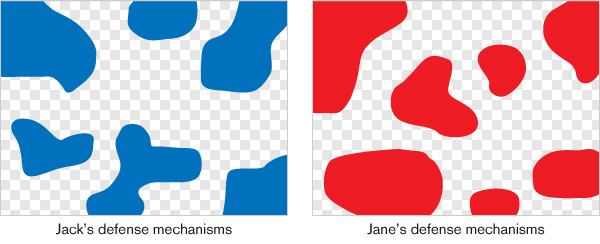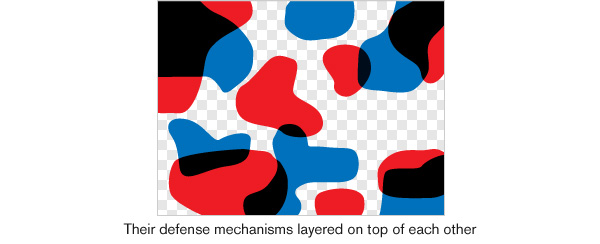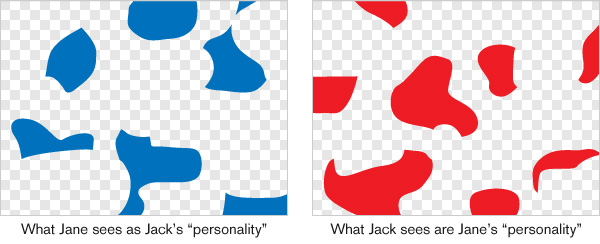Personality As a Collection of Defense Mechanisms
Defense mechanism is a way to cope with inconvenient reality; one that could potentially cause us pain. We develop an unconscious habit to block out or distort certain areas of reality. This means we are blind to these areas of reality for which we develop defense mechanisms. For this discussion we define “reality” as what each person perceives without obstruction or distortion created by his mental process. We need not define this “reality” as something absolute or universal. In some cases this “reality” does vary person to person (e.g. color blindness), but in most cases “reality” is the agreement (or the alignment) we take for granted. The illustrations below represent the reality with areas of obstruction (defense mechanisms).

On the left is Jack’s defense mechanisms. These blue areas block his view of the reality (the checkered area represents the reality). On the right is Jane’s defense mechanisms which block different areas of the reality. Now, when these two people start interacting with one another, what happens is below.

The black areas are where their defense mechanisms (blind spots) overlap. Jack and Jane are both blind to these areas, so they are not consciously aware of these areas. Now take a look at how this looks from the point of view of Jack and Jane separately.

On the left is how Jane sees Jack. When Jack’s defense mechanisms are triggered in the blue areas, Jane would consciously notice it because her own views of the reality are not blocked in these areas. She shares the same defense mechanisms in the black areas. Even though she is not conscious of these areas, if Jack’s defense mechanisms are triggered in these areas, Jane would unconsciously sense it and find it annoying. That is, she would project her own weaknesses onto him.
What we commonly call “personality” is a set of defense mechanisms that are consciously perceivable by the observer. If both Jack and Jane are looking at an aspect of reality where neither have defense mechanisms, both would see the same reality as is. There would be no disagreement and both would take it for granted. (i.e. Jack sees an apple and Jane sees an apple.) To Jack, the memorable aspects of Jane are those that are different from his, and vice versa. These aspects are collectively remembered as “personality”. The illustrations below represent “personalities” of Jack and Jane.

On the left is Jack’s personality as seen by Jane and on the right is Jane’s personality as seen by Jack. In other words, “personality” changes depending on who is observing that person, and it is defined by the combination of the defense mechanisms of the observer and the observed.
Theoretically speaking, if someone had no defense mechanism at all, he would not have any recognizable or memorable “personality”. However, it is possible for him to consciously create a “persona” that can be recognized and remembered by others. In other words, “personality” is what we are remembered by that we have no control over whereas “persona” is what we are remembered by that we can control.
What we call “spiritual growth”, “enlightenment”, or “self-discovery” is a process in which we try to eliminate as much of personality as possible and replace it with as much of “persona” as possible.
Subscribe
I will email you when I post a new article.


